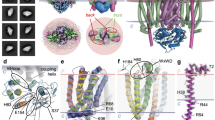Abstract
Maturation of c-type cytochromes involves the covalent and stereospecific enzymatic attachment of a heme b via thioether linkages to two conserved cysteines within apocytochromes. Horse cytochrome c is readily matured into its native holoform in the cytoplasm of E. coli when co-expressed with yeast cytochrome c heme lyase. Here we report the low yield formation of holocytochrome with covalently attached heme also in the absence of heme lyase. This is the first demonstration of in vivo maturation of a eukaryotic cytochrome c in a prokaryotic cytoplasm without the assistance by a dedicated enzymatic maturation system. The assembled cytochrome c can be oxidized by cytochrome c oxidase, indicating the formation of a functional protein. The absorption spectrum is typical of a low spin, six coordinated c-type heme. Nevertheless, minor spectral differences relative to the native cytochrome c, deviation of the midpoint reduction potential and slightly altered kinetic parameters of the interaction with cytochrome c oxidase emphasize the importance of cytochrome c heme lyase in folding cytochrome c into its native conformation.
Similar content being viewed by others
References
Angstrom J, Moore GR, Williams RJP (1982) Biochim Biophys Acta 703(1):87–94
Ausubel FM, Brent R, Kingston R, Moore DD, Seidman JG, Smith JA, Struhl, K (1996) Current protocols in molecular biology.
Barker PD, Ferguson SJ (1999) Structure 7(12):R281–R290
Bartsch RG (1971) Methods Enzymol. 23:344–363.
Bernard DG, Quevillon-Cheruel S, Merchant S, Guiard B, Hamel PP (2005) J Biol Chem 280(48):39852–39859
Bowman SE, Bren KL (2008) Nat Prod Rep 25(6):1118–1130
Craig DB, Nichols ER (2006) J Chem Educ 83(9):1325–1326
Daltrop O, Ferguson SJ (2003) J Biol Chem 278(7):4404–4409
Daltrop O, Allen JW, Willis AC, Ferguson SJ (2002) Proc Natl Acad Sci USA 99(12):7872–7876
Dolgikh DA, Latypov RF, Abdullaev ZK, Kolov V, Roder H, Kirpichnikov MP (1998) Bioorg Khim 24(10):756–759
Giege P, Grienenberger JM, Bonnard G (2008) Mitochondrion 8(1):61–73
Greenwood C, Wilson MT (1971) Eur J Biochem 22(1):5–10
Guzman LM, Belin D, Carson MJ, Beckwith J (1995) J Bacteriol 177(14):4121–4130
Hamel P, Corvest V, Giege P, Bonnard G (2009) Biochim Biophys Acta 1793(1):125–138
Harrington JP, Carrier TL (1985) Int J Biochem 17(1):119–122
King TE (1967) Methods Enzymol. 10:202–208
Kranz RG, Richard-Fogal C, Taylor JS, Frawley ER (2009) Microbiol Mol Biol Rev 73(3):510–528
Levantino M, Huang Q, Cupane A, Laberge M, Hagarman A, Schweitzer-Stenner R (2005) J Chem Phys 123(5):054508
Margoliash E, Lustgarten J (1962) J Biol Chem 237(11):3397–3405
Margoliash E, Schejter A (1966) Adv Protein Chem 21:113–286
Patel CN, Lind MC, Pielak GJ (2001) Protein Expr Purif 22(2):220–224
Pollock WB, Rosell FI, Twitchett MB, Dumont ME, Mauk AG (1998) Biochemistry 37(17):6124–6131
Rumbley JN, Hoang L, Englander SW (2002) Biochemistry 41(47):13894–13901
Sanbongi Y, Yang JH, Igarashi Y, Kodama T (1991) Eur J Biochem 198(1):7–12
Sanders C, Lill H (2000) Biochim Biophys Acta 1459(1):131–138
Schweitzer-Stenner R, Levantino M, Cupane A, Wallace C, Laberge M, Huang Q (2006) J Phys Chem B 110(24):12155–12161
Sinha N, Ferguson SJ (1998) FEMS Microbiol Lett 161(1):1–6
Spilotros A, Levantino M, Cupane A (2010) Biophys Chem 147(1–2):8–12
Tenger K, Khoroshyy P, Leitgeb B, Rákhely G, Borovok N, Kotlyar A, Dolgikh DA, Zimányi L (2005) J Chem Inf Model 45(6):1520–1526
Tenger K, Khoroshyy P, Kovács KL, Zimányi L, Rákhely G (2007) Acta Biol Hung 58:23–35
Thony-Meyer L (1997) Microbiol Mol Biol Rev 61(3):337–376
Thony-Meyer L (2002) Biochem Soc Trans 30(4):633–638
Thony-Meyer L, Fischer F, Kunzler P, Ritz D, Hennecke H (1995) J Bacteriol 177(15):4321–4326
Tomlinson EJ, Ferguson SJ (2000) J Biol Chem 275(42):32530–32534
Vargas C, McEwan AG, Downie JA (1993) Anal Biochem 209(2):323–326
Yonetani T (1967) Methods Enzymol. 10:332–335
Author information
Authors and Affiliations
Corresponding author
Rights and permissions
About this article
Cite this article
Tenger, K., Khoroshyy, P., Rákhely, G. et al. Maturation of a eukaryotic cytochrome c in the cytoplasm of Escherichia coli without the assistance by a dedicated biogenesis apparatus. J Bioenerg Biomembr 42, 125–133 (2010). https://doi.org/10.1007/s10863-010-9276-9
Received:
Accepted:
Published:
Issue Date:
DOI: https://doi.org/10.1007/s10863-010-9276-9



